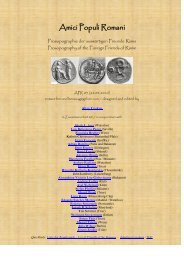1 Lokales und römisches Bürgerrecht: Das Beispiel der Iulii von ...
1 Lokales und römisches Bürgerrecht: Das Beispiel der Iulii von ...
1 Lokales und römisches Bürgerrecht: Das Beispiel der Iulii von ...
Create successful ePaper yourself
Turn your PDF publications into a flip-book with our unique Google optimized e-Paper software.
Interconnectivity Conference, Constanta 2013<br />
it is a worthwhile endeavour to study the possible impact of the mixed Hellenistic/Near-<br />
Eastern religious policies in Asia Minor on the further developments of oracular resistance<br />
literature.<br />
Mithridates the Great and the Freedom of the Greeks<br />
Prof. Glenn BUGH<br />
(Virginia Tech, Blacksburg VA)<br />
In the prospectus of the Second Athenian League (378/7 BC), Athens promised that its<br />
members would be allowed “to be free and autonomous, with their own government, neither<br />
receiving a garrison nor submitting to a governor nor paying tribute”. These promises<br />
continued to be made by the Successors of Alexan<strong>der</strong> the Great. Of course, freedom granted<br />
by others is a gift that can be taken away. It is in this context that Mithridates VI Eupator‟s<br />
relationship with the Greek poleis of the Black Sea needs to be investigated. At their request,<br />
Mithridates‟ generals freed the Greek cities from Scythian pressure and created a Pontic<br />
protectorate. It will argue that the model for Mithridates‟ foreign policy in the Black Sea<br />
region was that long formulated by the Seleucids in their realm. They shared close ties. Not<br />
only did the Mithridatids and Seleucids have Greek and Persian ancestors, but the Pontic<br />
kings had inter-married with the Seleucids as far back as the 3 rd century BC. And the Seleucid<br />
king Antiochos VIII Epiphanes (Grypos) is honored on the famous Mithridates Monument on<br />
Delos (101 BC).<br />
L‟interconnexion des réseaux économiques :<br />
les échanges entre le Pont nord-ouest et Rhodes à l‟époque hellénistique<br />
Thibaut CASTELLI, Doctorant en Histoire Ancienne<br />
(Université Paris Ouest Nanterre La Défense)<br />
De l‟estuaire du Bug à la Dobroudja, à partir du IV e siècle la présence rhodienne est<br />
marquée principalement par des vestiges d‟amphores, aussi bien dans les cités grecques que<br />
dans l‟hinterland occupé par des Gètes et des Scythes. L‟étude, à partir de quelques exemples,<br />
des réseaux d‟échanges qui ont permis d‟amener ces milliers d‟amphores nous permettra de<br />
mettre en valeur le rôle des cités grecques comme interface entre deux réseaux commerciaux :<br />
le réseau rhodien et le réseau des cités pontiques vers l‟intérieur du continent. L‟examen des<br />
relations interpersonnelles connues par des inscriptions sera ensuite complété par une analyse<br />
des éléments archéologiques (monnaies, amphores) qui témoignent du fonctionnement de ces<br />
réseaux interconnectés.<br />
Roman Glass Vessels in the West Pontic Area (1 st -3 rd Centuries AD). General Remarks<br />
Dr. Costel CHIRIAC (Institute of Archaeology, Iaşi)<br />
Sever BOȚAN, PhD Candidate (Alexandru Ioan Cuza University, Iaşi)<br />
The authors wish to present an overview of the main types of glass vessels from the<br />
early Roman age that were discovered in the area between Olbia and Byzantium. Although it<br />
has been colonized early by the Greeks who were scattered all aro<strong>und</strong> the Black Sea Basin,<br />
the West Pontic seashore has, nevertheless, several specific peculiarities that differentiate it<br />
from the Black Sea‟s North shore – especially the quantity of import goods that started to<br />
penetrate the region in the early Roman age. Apparently, on the Western shores, the level of<br />
economic interception and the local market‟s absorbance rate were lower than those of the<br />
4



